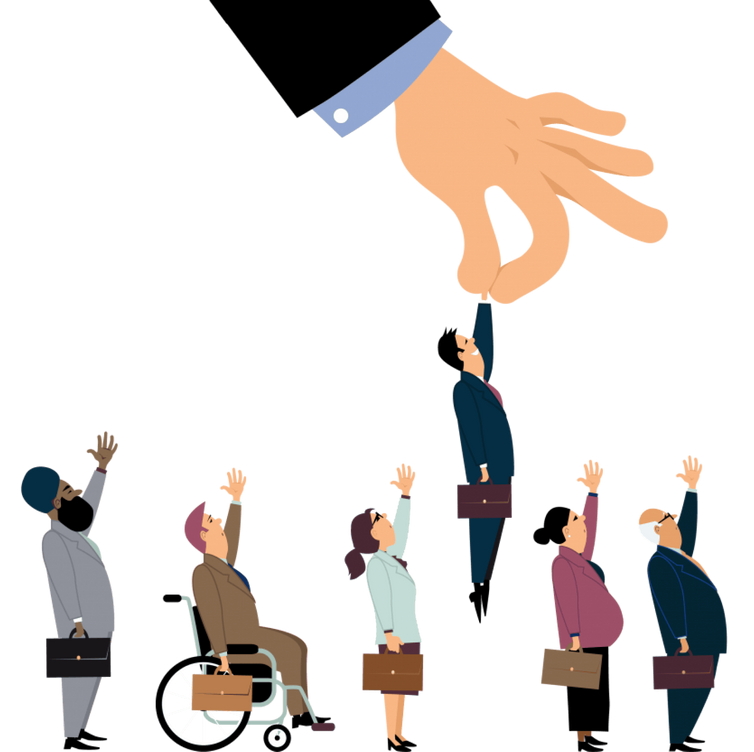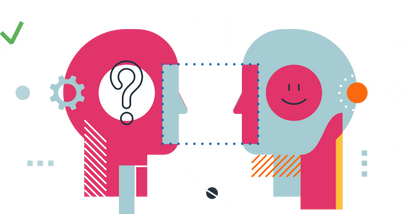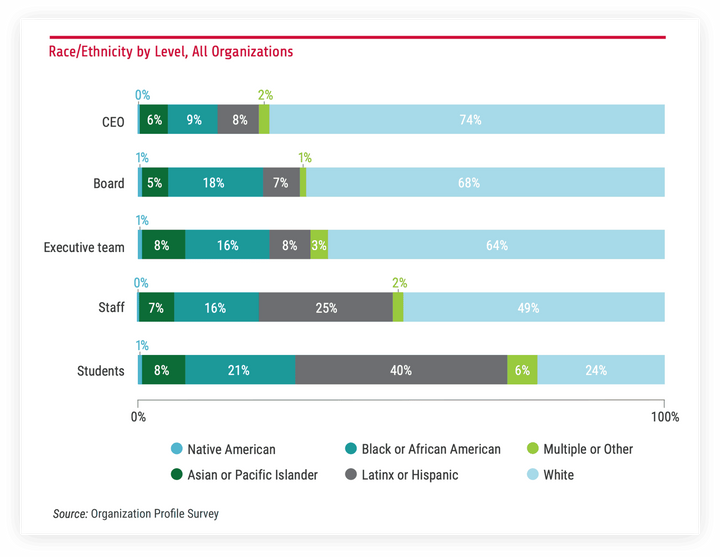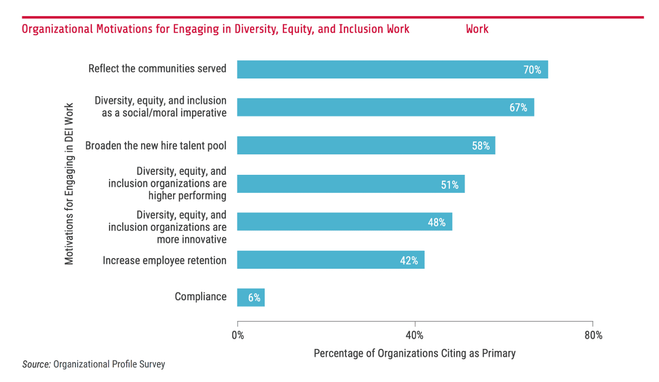Types of Hiring Biases and How to Reduce Them
Written by
Lauren BarberAbout the Author
Lauren is a Senior Content Manager at VidCruiter, with expertise in technology and human resources. She is celebrated for her contributions to Forbes, Fast Company, Meta, Lyft, and McCain.
Reviewed by
VidCruiter Editorial TeamAbout the Author
The VidCruiter Editorial Team offers practical recruitment advice, drawing on insights from seasoned professionals. Our award-winning content, supported by industry specialists, underscores VidCruiter's dedication to innovation in recruitment.
Last Modified
March 25, 2024Research has shown that—far too often—racism, sexism, ageism, and other worrying hiring biases creep into recruitment processes. Not only does it make the interviewing process unfair for candidates, it can negatively affect the quality of your hires and introduce some major risks to employers’ reputation and bottom line.
Table of Contents
What is hiring bias?
Interviewer bias is when different, unfair standards are applied when evaluating people to hire (or promote) within a company or organization. It can lead to passing over high-potential candidates for lesser hires simply because of interviewer partiality.
Unfortunately, bias is common and pervasive, both in society and some recruitment processes. Prejudices sneak into the minds of those conducting job interviews, clouding judgment and negatively influencing decision-making.
There are two types:
Conscious hiring bias
Sometimes interviewers can recognize their own (and/or others’) preference or dislike for certain kinds of individuals. They may even voice these conscious biases, which are also known as explicit biases.
Let’s say a hiring manager prefers to work with women over men. As a result, they hire women disproportionately to men. This is just one example, but compared to unconscious bias, conscious biases in the hiring process tend to be easier to spot and stamp out.
Unconscious hiring bias
More often, bias creeps into the hiring process quietly, unexpectedly, and subconsciously. It’s what happens when you “trust your gut” or “follow your intuition,” ignoring important evidence and not exercising critical thinking. These beliefs stem from stereotypes and/or personal past experiences. But these unconscious biases are usually deeply ingrained within an interviewer, so they’re harder to identify.
To illustrate one of the many forms unconscious bias can take, consider a hiring manager deciding between three qualified candidates for a position. When making the final decision, the hiring manager unknowingly selects the candidate who reminds them of themself when they were younger and has a cultural background similar to most employees of the organization.
Hiring managers and recruiters need to evaluate candidates’ ability to do a job well—rather than rely on subjective assumptions. Thankfully, as we become more aware of these biases, we can start to challenge and change certain ways of thinking.
When does hiring bias arise?
Hiring bias can occur at any stage of the talent acquisition process—regardless of the selection process you choose. Some people think hiring bias only occurs when it’s time to make a job offer, but it usually occurs much sooner than that, and it frequently persists throughout each step.
Recruitment bias can pop up in the initial screening stages when candidates are dismissed based on information that appears on their resume. Certain names suggest or reveal a particular gender, race, and/or age bracket. We’ll dive deeper into this topic in the next section, but for now, understand this: if biased recruiters have a pre-set idea of what type of person they want to hire for a position (e.g., an older white man), other candidates (who may be more promising!) are often prematurely overlooked.
Of course, hiring bias also occurs at the interview stage.
Hiring bias can arise in any interview format:
- Phone interviews (judging someone by the sound of their voice)
- Video interviews (pre-recorded or live)
- In-person interviews

Ways to overcome hiring bias
Change has to start somewhere, but it can be hard to know where to begin when you’re tackling something as big as hiring bias. Some AI and automated employment decision tools (AEDTs) claim they mitigate or drastically reduce bias in the hiring process, but they have not been endorsed by regulatory agencies and could be a potential legal liability.
Here are some steps you can take to recognize and mitigate the impact of biases.
Offer awareness training
Corporate anti-bias training brings biases to the surface, allowing people to more easily identify subjective thinking when it pops up during interviews. Once people are aware of their personal biases, they are better prepared to challenge them. However, when offering training keep in mind that some elements of DEI are incredibly nuanced, and a one-size-fits-all DEI training might not work for your staff.
You may also want to consider making DEI and implicit bias training mandatory for hiring managers and recruiters. We know from research that the awareness that comes from unconscious bias training doesn’t last, so doing these sessions on a recurring basis is necessary to maintain their effectiveness. If you want to improve the positive impact of DEI training, make sure it’s part of a wider strategy for change and equity in the hiring process.
Ask candidates to perform skills tests
Another way to reduce bias in the recruitment process is to ask applicants to complete a skills test. This step is often done even before interviewing because it helps set an objective standard in the early stages of hiring. Consider hiding applicant names during initial screening as blind assessments help reduce name bias.
Skills tests relate directly to the type of tasks involved in the day-to-day job, allowing the candidate to prove that they have what it takes to succeed in the position. It also helps employers critique the quality of candidates’ responses rather than judging them by factors that do not relate to their ability to do the job well.
Involve multiple people in the hiring process—and document their ratings
Try to create a diverse hiring committee, ideally one that includes one or more interviewers from underrepresented groups. Ideally, you want applicants to see people who look like them already working for the organization, helping them feel welcome. Some organizations are adopting this best practice from the top down by hiring a Chief Diversity Officer or Compliance Manager.
Getting multiple peoples’ opinions helps mitigate the possibility of similarity bias. Interviewers will likely have different interests and backgrounds, so some will have more in common with the candidate than others.
A major benefit of bringing in different hiring stakeholders is cognitive diversity. Different people have different ways of thinking, and some organizations will ask interviewers to rate only one interview answer for each applicant. This practice can help diversify the evaluation and add more visibility into potential recurring bias by spotting rater trends.
Remember: recorded video interviews can serve as a permanent record of your hiring process history. By reviewing these videos, you can more easily assess patterns and spot recurring bias from interviewers in order to address it.
Create standardized questions
Before interviewing job applicants, take time to specify exactly what questions you want to ask. What are you hoping to find out about the aptitude of interviewees? What skills are needed for each specific position? Your questions should only relate to the core competencies of the job.
Standardized questions should be asked to all applicants. Not only should every candidate be asked the exact same questions, they should be asked in the same way and in the same order every time. This ensures all candidates receive the same interview experience, minimizing bias.
Establish fair, repeatable scoring criteria
To maximize the chances of candidates being evaluated fairly and consistently, clearly define metrics that will be used to assess people’s suitability for different job positions. Rank the selection criteria, establish expectations with committee members, and ensure everyone is using the same evaluation matrix.
By making sure everyone is using the same scoring baseline, it helps reduce bias and favoritism. Static competency-based hiring criteria, which is the basis of structured interviews, is an important part of making an apples-to-apples comparison between potential hires.
What types of biases exist?
Like people, biases come in many shapes and sizes. The first step to mitigating hiring bias—especially unconscious bias, which can be tricky to spot—is learning about the different kinds of biases you will encounter as an HR professional.
Confirmation bias
One of the most common cognitive biases is confirmation bias. This is when someone has a belief about a candidate — negative or positive — and unknowingly, they are trying to prove themself right. While it feels good to be right, it’s important to challenge your confidence. Confirmation bias can show up in how an interview is conducted, how the candidate’s answers are perceived, and how the candidate is remembered.
Selective search: This is when negative evidence is disregarded and only positive evidence is sought out in interviews. An example would be asking leading questions to try and elicit answers that support your assumptions about a candidate.
Selective interpretation: If three interviewers watched back the same pre-recorded interview answers, they might all give completely different evaluations even though they watched the same videos. Confirmation bias shapes how they might evaluate the interview to further reinforce their existing beliefs.
Selective recall: This is the tendency to recall information that’s in line with your position. This is why it’s easier to remember specific things about a candidate you want to hire, and why you might struggle to remember the same level of detail about a candidate you passed on.
Race and ethnicity bias
According to National Geographic, race is “usually associated with biology and linked with physical characteristics such as skin color or hair texture.” Ethnicity, on the other hand, is “linked with cultural expression and identification.” These social constructs are used to group seemingly distinct populations together—but too often that comes with negative consequences.
While we’d like to think our society has made tremendous strides in reducing racism, regrettably, some interviewers still judge people because of their race, nationality, ancestry, or place of origin. For example, research shows no change in the levels of discrimination against African Americans since 1989, documenting a “striking persistence of racial discrimination in U.S. labor markets.”
Name bias
Along the same lines as racial and ethnicity biases is name bias. This is when candidates are judged based on their name alone. It happens more frequently in the recruitment process than you might think.
A research study revealed applicants with stereotypically white-sounding names were offered 50% more job interviews than applicants with African American-sounding names—even though the resumes were identical!
In addition to missteps with race, name bias can also come into play when interviewers arbitrarily assign an assumed age to an applicant based on what appears on their resume. Applicant names can also unintentionally reveal an applicant’s gender or age. Names like Edith and Eugene bring to mind candidates in an older age bracket than Juniper or Jaxson.
Gender bias
Gender bias is a preference or prejudice toward one gender over another. Gender itself is a nuanced topic full of complexities, and the spectrum of gender fluidity within society has changed over time.
At this point in time, widespread stereotypes cause some interviewers to mistakenly believe men are always better hires than women for certain positions, such as those involving math and science. Similarly, hiring committees may favor women for nurturing roles like nursing and teaching.
When it comes to gender stereotyping in recruitment, the odds are stacked against women. Women are still underrepresented in the workforce, particularly within certain industries such as jobs in IT.
74% of women in technology jobs, such as software development or data science, say they have experienced discrimination because of their gender.
Although interviewers cannot legally ask candidates if they are pregnant (or plan to have children), women often face pregnancy discrimination throughout their career, too.
Women also typically make less than male counterparts—and that’s when they’re successful in landing work.
A study by Harvard Business Review showed if there’s one woman candidate up against three male candidates, she has 0% chance of being offered the job. There’s statistically ZERO chance she’ll be hired.
Sexual orientation bias
A person’s sexual orientation should have no correlation to how well someone can perform on the job. And yet, some interviewers still have prejudices against applicants based on an actual or assumed sexual orientation.
The LGBTQ2+ abbreviation (lesbian, gay, bisexual, transgender, queer or questioning, and two-spirited) covers many types of sexual orientations and gender identities of job applicants. The plus-sign at the end signifies there are even more. But whether an applicant is heterosexual, homosexual, bisexual, pansexual, or asexual, it shouldn’t matter so long as the candidate has the necessary skills to do the job well.
Nearly one quarter (23.7%) of LGBTQ Americans have experienced discrimination based on sexual orientation or gender identity when applying for jobs.
Age bias
Age (or generational) bias in the hiring process involves making unfair assumptions about someone based on their actual or assumed age. This bias is especially common in the technology industry where interviewers tend to believe that older people can’t possibly be as tech-savvy as younger people.
But both baby boomers and Gen Z face the potential for age bias.
Researchers used pairs of CVs that differed in only birth date and graduation years to investigate age bias. When they applied for jobs seeking a “new graduate,” older applicants faced 60% age discrimination. When they applied for more senior managerial jobs, younger applicants were 70% less likely to get the job than older applicants.
The Age Discrimination in Employment Act (ADEA) of 1967 is a federal law that prohibits discrimination against employees and applicants aged 40 or older in the United States. While that was a great step forward in fighting age-related bias, unfortunately, examples of ageism in the workplace are still rampant. Furthermore, the ADEA does not legally protect anyone 39 or below, leaving young people on the opposite side of age discrimination at risk.
More than four decades after the ADEA became law, nearly two-thirds of workers aged 55 to 64 report that their age is a barrier to getting a job. Despite having loads of experience, older individuals may be passed over because they’re nearing retirement age. They are often on the receiving end of age-related comments or jokes in the workplace. Lapses in memory, which occasionally happen to all of us, can be exaggerated and seen as senility. And ageism is still vastly underreported: only 3% of older employees have ever made a formal complaint.
Age bias can be very difficult to prove because it usually comes out in the subtleties of language. While it’s illegal, the penalty is typically not very big as this is a sort of “accepted bias.” As a culture, we tend to be overly forgiving of this form of discrimination. But this bias presents plenty of danger from a recruitment perspective.
Automation bias
Automation bias is a phenomenon that occurs when people give undue weight to technologically-created information (such as artificial intelligence). When predictions, numerical scores, or rankings are presented as precise and objective because they’re “computer-generated,” recruiters may give them more weight than they truly warrant.
Religion bias
Religious discrimination involves treating applicants unfavorably because of their religious beliefs or spiritual observances. Religion should never factor into hiring decisions. Make an effort to separate church and cubicle.
Affinity bias
Affinity bias, also known as commonality bias or similarity bias, is when interviewers gravitate toward hiring people they have something in common with. It’s a natural instinct rooted in a desire to belong and connect, but in practice, it’s implicit prejudice. Perhaps a member of the recruitment team lived in the same city, went to the same school, or knows the same people as an applicant, so they unfairly rate them higher than other candidates.
Part of this is human nature; people want to belong, so they tend to hire candidates who are like them. But this limits diversity in the workplace. Affinity bias creates a “personality silo” where skills become secondary to similarities.
Affinity bias can be closely tied to in-group favoritism, where people form positive feelings for others they perceive as members of their in-group and negative feelings about those who are not. Research proves that whether groups are randomly assigned or formed based on a unifying factor, people still demonstrate loyalty toward their group.
Conformity bias
Conformity bias happens when people behave like those around them instead of using their judgment. We learn how to act by taking behavior cues from others as children, and this can turn into conformity bias in professional situations.
It occurs when interviewers unknowingly change their minds to side with the majority of people. For example, if four out of five interviewers all say candidate #3 was by far the strongest applicant, oftentimes the outlier (depending on how impressionable they are) will agree #3 is the best fit for the position—even when they originally preferred someone else—to fit in.
Halo and Horns Effect
The halo and horn effect is about making snap judgments based on a perceived positive or negative attribute. In both situations, it’s a failure to see the candidate as a whole.
The halo effect comes into play when an interviewer becomes biased by certain positive things about a candidate that have no bearing on their ability to do a job well. Because of this, the interviewer will disregard red flags and focus too much on a particular aspect of an applicant, such as where they went to university or an old award they received once upon a time.
The horn effect is the opposite of the halo effect. It comes into play when interviewers cannot move past something they perceive as “negative” (but unrelated to the job) about an applicant. Maybe the candidate has visible tattoos or piercings. Perhaps they have the same name as an ex-partner from a relationship that ended poorly. These are just a couple examples of the horn effect leading recruiters to skip over candidates who would otherwise be deserving of an interview.
Beauty bias
Beauty bias, also known as “lookism” or attractiveness bias, comes into play when interviewers subconsciously believe how a person looks affects how they will perform in the job. This is consistent with broader findings of a well-established halo effect where people who fit within Western beauty standards are perceived as being more sociable, healthy, successful, honest, and talented.
As a result, conventionally attractive people tend to secure more interviews and get hired and promoted more easily, despite not necessarily being the best candidates for the position.
When asked to assess the centrality of employee appearance to business success, 93% of employers said it was either critical or important.
Proximity bias
While it’s been around for a long time, proximity bias is a bigger topic than ever now that hybrid work is on the rise, and so many have switched to working remotely. People in power tend to treat those who are physically closer to them, or they see more often, better. To summarize: the more familiar someone is, the more likely you are to favor them. This can even extend forward to how familiar someone might become.
If a job hunt came down to two strong candidates, one would be a fully remote worker, and the other would be hybrid, proximity bias might mean the remote employee is at a disadvantage. Overvaluing candidates who say they will come into the office vs. those who are clear about working from home is something to watch out for a while hiring.

A 2015 study showed that remote workers at a travel agency had higher performance levels while simultaneously losing out to in-house staff on performance-based promotions. This demonstrates the importance of making decisions based on data or knowledge, not biases.
Disability bias
Disability discrimination is when individuals with “a disability, perceived disability, or association with a disabled person” are treated differently than other candidates. Differently-abled job applicants may be in a wheelchair or have an amputated limb, but remember: not all disabilities are easy to spot. Consider visual disabilities, auditory disabilities, and learning disabilities, for example. 62% of white-collar, college-educated employees with disabilities identified their disability as “invisible.”

“The bigger question is this: How can we make interviews inclusive and welcoming for every applicant, regardless of their disability or whether they have a disability at all?”
Claire Odom
Senior Program Manager
Understood“The bigger question is this: How can we make interviews inclusive and welcoming for every applicant, regardless of their disability or whether they have a disability at all?”

The hiring biases listed above are among the most common. There are several other types of bias to be aware of, but these are the most damaging hiring biases within talent acquisition teams. While it would be impossible to eliminate bias altogether, you can certainly be aware of the repercussions and take steps to mitigate bias in the hiring process.
The dangers of hiring bias
Hiring managers and recruiters frequently (but mistakenly) rely on their intuition to make hiring and promotion decisions. When left unchecked, these biases shape and limit the workforce and the entire company culture. When bias enters into hiring decisions, it can cost you time, money—and your company’s reputation.
Potential legal consequences
Perhaps the most obvious—and potentially the most damaging to your company—are the legal consequences of discriminatory hiring practices. Biased interviews leave your business wide open to an expensive lawsuit.
After all, some biases aren’t only frowned upon; they’re illegal. Laws vary depending on location, but large countries such as the United States, Canada, the United Kingdom, and Australia have all taken steps to protect job applicants from employment discrimination. These “protected groups” may be based on race, religion, sex, age, disability, or other candidate characteristics. Or, they can protect certain statuses, as in the case of protected veterans.
Negative brand reputation
Biased hiring decisions can damage your brand’s reputation. If your company hires someone unfit for the position because of interviewer bias, the general public may see the brand in an undesirable light. The wrong hire may be rude or indifferent to customers, who then tell their friends, creating a negative feedback loop.
Discourages top talent from applying
If your company has developed a reputation of biased hiring, this can discourage high-performing talent from applying for current and future positions. Good employees are tough to come by and your company is doing nothing to help promote itself and attract well-qualified people if it doesn’t make proactive efforts to minimize bias.
Increases turnover
Bias often leads to hiring the wrong people, increasing turnover rates. Whether the employee chooses to leave on their own or HR needs to fire them, losing staff wastes valuable time and money that would be better spent growing the right employees.
Reduces sales
Hiring the wrong people can negatively impact sales, reducing the company’s bottom line. So, if profit is part of the reason your company is in business, then you need to take a serious look at bias in your recruitment process.
Lack of diversity
When bias increases, diversity tends to decrease. And that’s bad for business. One-dimensional workforces where everyone who’s hired is the same are not as successful as employers with diverse teams. We’ve got a lot more to say about the importance of workplace diversity, so let’s jump in.
Why promote diversity in the workforce
There’s a dotted line between bias and diversity. Hiring bias can negatively affect even the best laid DEI plans of your organization.
DEI, which stands for Diversity, Equity, and Inclusion, is now a common term among HR professionals. DEI efforts aim to make hiring processes more equitable, accessible, and inclusive. They seek to remove barriers and favorable treatment, championing human rights and dignity.
Diversity
Diversity encourages the representation and participation of diverse groups of people. While characteristics like race, age, and gender jump to mind, diversity includes all the things that make people unique: our personalities, backgrounds, skill sets, interests, perspectives, and more.
Diverse workforces can offer:
- A variety of different perspectives
- A wider range of skill sets
- Increased innovation and creative problem solving
- Greater employee engagement
- Increased job satisfaction
- Lower turnover
- Improved public perception
Equity
Equity promotes justice, impartiality, and fairness within HR processes to ensure everyone has access to the same treatment and advancement opportunities.
Inclusion
Inclusion is about trying to make each person feel valued and welcomed. Inclusive recruiting practices help create a positive candidate experience, setting the tone for what future employment might look like.
An important note about equity:
Many people mistakenly use the words ‘equity’ and ‘equality’ interchangeably. Equality means giving everyone the exact same resources and opportunities, whereas equity involves distributing resources and opportunities based on the needs of the recipients. After all, some job applicants and employees need more support than others. This graphic attempts to illustrate the difference.
Diverse workforces are more representative of the human race as a whole. They offer lots of value for employers and employees alike, including:
Greater employee engagement and creative problem solving
59% increase in creativity, innovation, and openness
Improved public perception
Organizations with inclusive cultures and practices are 58% more likely to improve their reputations.
Attracts Talent
2/3 of workers cite diversity as an important factor when considering a new organization.
Employees on diverse, inclusive teams typically have a heightened sense of belonging and higher levels of job satisfaction. This often leads to staff retention, so hiring teams save time and money from reduced turnover.
DEI efforts help foster high levels of productivity, which can contribute to increased revenue and better shareholder returns. A study from McKinsey & Company found evidence that suggests diversity correlates with better financial performance.
The bottom line is this: DEI helps attract top talent and keep your hires happy. Millennials place an even higher value on diversity and inclusion than previous generations, so as we build the workforce of the future, we must be mindful of ways to appeal to young job seekers.
Employers everywhere have recognized the many benefits of diversifying their teams, and they’re taking action—starting with overcoming bias in the recruitment process.
Why structured interviews mitigate bias better than unstructured interviews
Thankfully, the interview process can be intentionally designed to minimize common hiring biases.
The recommendation to create standardized questions with fair and consistent evaluation in the Ways to Overcome Hiring Bias section above combine to create a standardized interview process. Structured interviews yield far more objective results than their unstructured counterparts. By standardizing the interview questions and making every interviewer score the applicant individually and based on the same evaluation criteria, you are creating an inclusive and proven process that makes things easier for the hiring team and fairer for applicants.
Let’s unpack what makes structured and unstructured interviews so different.
It’s a hiring best practice, yet, it can be challenging for HR teams to adopt standardized interviews, especially when hiring stakeholders are spread out and working remotely.
Progressive technology is paving the way to smarter, more objective, legally-defensible hiring decisions. Structured interviews use the same methodology — the only difference is that the interviews are done over video. This offers the candidates and interviewers more flexibility to interview from anywhere and creates a data set for the organization to analyze and learn from so they can improve on their own hiring decisions.
Think you can pick the best candidate just by looking at their resume or engaging in a casual conversation? Think again. If you start to rely on your own abilities and estimations more than you do facts, that’s called overconfidence bias. It doesn’t matter if you’re just starting your career or if you’re an HR pro. Anyone can fall prey to trusting their ideas, skills, and knowledge more than something like ratings data (a key feature of structured interviews).
Overconfidence can also lead to a “bias blind spot” phenomenon, where you might think you’re less likely to be biased than your peers.

Are HR practitioners overconfident when it comes to bias?
A study in the German Journal of Human Resource Management did a quantitative survey among 234 HR employees in Switzerland measuring the bias blind spot on seven interview biases in recruitment decision-making. The study found that participants rated their colleagues as more susceptible to bias than themselves, and male HR employees showed a greater bias blind spot than female HR employees.
To recap, implementing a structured interview methodology—especially one that has been digitized for easy adoption within video interviewing software— has many benefits.
It allows you to…
- Reduce the likelihood of interviewers asking off-topic questions
- Increase the probability of hiring the right people
- Mitigate personal bias
- Support DEI goals
- Build a process that your organization can continually build and improve on

“We have to provide an experience that is equal to everyone no matter the circumstances.”
Georg Peitchev
Human Resources Specialist
UNDP
“We have to provide an experience that is equal to everyone no matter the circumstances.”

Georg Peitchev
Human Resources Specialist
UNDP
Future proofing unfair hiring practices
As we’ve learned, hiring bias and workforce diversity are complicated, ever-evolving topics. There’s lots to unpack, and we’ve just skimmed the surface of all the complexities surrounding recruitment bias. There’s plenty more to discuss, more opinions to gather, and more work to do.
One thing’s for certain: we must keep the conversation going.
We’ll never manage to minimize bias and achieve diverse workplaces by staying silent when we notice injustices. Empower people to speak up if inappropriate comments or jokes are made throughout the hiring process. Try to recognize stereotyping and potential prejudice in yourself and those you work with. We must collectively work to create greater awareness about hiring bias so we can minimize its negative influence.
If your organization wants to be truly invested in diversity, it starts with analyzing your recruitment process.
It’s time to take the leap from intention to action.

